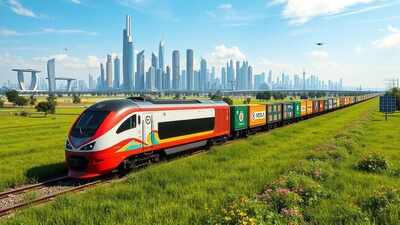Tracks of tomorrow: How smarter infrastructure can bring down India’s logistics costs

By MP SinghIndia is on a bold mission – to be a $30 trillion economy by 2047, the centenary of our independence. To achieve this ambitious dream, we require more than just aspiration; we need a coordinated approach, to enable an infrastructure spine which delivers swift, dependable and affordable movement of goods within the country. Currently, close to 60 percent of India’s freight still moves by road. While roads are critical for connectivity – especially for the last mile – relying primarily on them for long-haul freight is not the most efficient and strategic solution. Rail, a far more efficient and safer alternative for bulk transport, carries just about a quarter of our total cargo. Inland waterways, despite their huge potential, are used even less. Today, India spends nearly 14 to 18 percent of its GDP on logistics-related costs. This is a critical issue that needs to be addressed for making Indian manufacturing cost competitive. While railways are a better option when compared to roads for freight movement, freight trains largely travel at average speeds of 25 to 30 km/h, primarily because of congestion on tracks being shared with passenger trains and bottlenecks at critical yards. Ports, which should function as express gateways for export-import traffic, take 2-3 days to turn around, whereas the global standard for ports is 10-12 hours.However, the situation has now started taking a turn for the better. The Prime Minister’s Gati Shakti National Master Plan is leading the charge for a logistics revolution. For the first time, India is thinking about infrastructure planning in an integrated, coordinated manner. Instead of constructing roads, railways, ports, and airports in isolation, Gati Shakti brings all parties together on a common platform. This will let us plan in a more deliberate and deft manner, help avoid overlaps and link our networks with greater efficiency.Moreover, since 2014, Indian Railways have fast-tracked the delivery of critical projects, especially on high density routes by increasing capital expenditure substantially. The emphasis has been on commissioning projects linking major ports, production centres and mining areas. Concerted efforts have been made to eliminate network bottlenecks by carrying out major yard remodelling efforts and construction of rail flyovers on yards. Commissioning of Dedicated Freight Corridors (DFCs) on eastern and western corridors has started yielding rich dividends by accelerating cargo movement on the busiest routes of Indian railways and simultaneously improving the average speed of passenger trains on existing, busy rail routes.Beyond the rail tracks, the development of multi-modal logistics parks – hubs that bring together road, rail, and port connectivity in one place – has started taking shape. These centres will help assemble goods, reduce handling times, and cut down on inventory and warehousing costs. They are the logistical equivalent of Smart Cities – streamlined, tech-enabled, and designed for the future.Of course, technology is also playing a notable role in this shift. From GPS-enabled cargo tracking to digital customs clearance at ports, we’re witnessing the proliferation of real-time data availability and automation. Artificial intelligence is helping to predict freight demand, while blockchain is streamlining documentation and making cross-border movement smoother and more secure.But this shift and renewal is not just about technology and infrastructure, it must be bolstered by policy and people. Improved training is required for logistics professionals, and we need uniform rules between states, and quicker implementation of digital processes along the value chain. The government has already taken big steps with the GST- enabled E-way bill system: now the imperative is to keep the momentum going.The countries which have strengthened their freight railway network, have integrated the different modes of transport, and have removed various procedural bottlenecks in logistics movements have reaped ample benefits – most significantly with reduced logistics costs. India can – and must – adapt these principles to capitalise on its own strengths. With our demographic advantage, growing digital maturity, and strong political will, we’re in a better position than ever to make bold changes.Our objective should be to cut logistics costs down to 12 percent of our GDP by 2030. By 2040, it should be at par with global standards – 8 percent or below. This is about delivering far more than just reduced costs. It’s also about enhancing the ease of doing business, generating new employment, and enabling agile, sustainable, and more secure exports and goods movement.This is a national imperative – one that demands coordination at every level of government and industry. Each track we lay and each corridor we finish should be in aid of this vision. Organisations that have these mandates, must not view themselves as builders of rail infrastructure – instead, they should view themselves as facilitators of growth, efficiency, and opportunity.A truly developed India by 2047 will not be possible without world-class logistics. And world-class logistics starts are only possible with a smart, connected, future-ready infrastructure. The tracks for tomorrow are being laid today. And they are on the right course.(MP Singh is Director (Operations) at Rail Vikas Nigam Limited)





